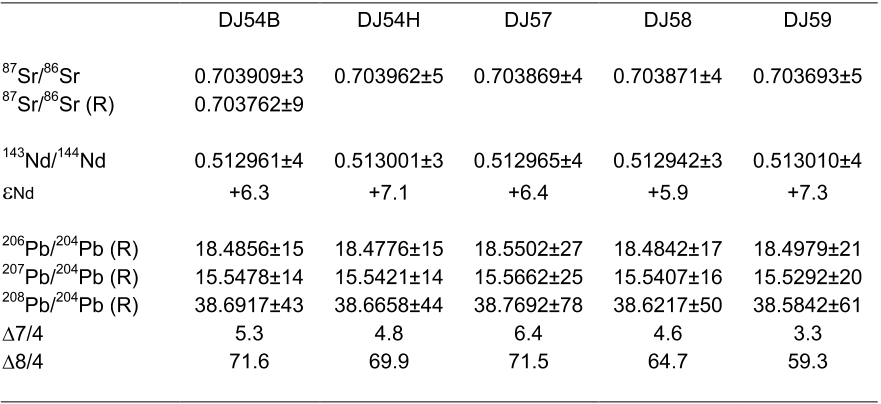A LREE-depleted component in the Afar plume; further evidence from Quaternary Djibouti basalts
Figures (8)

Table 2 (continued).4 5 
Table 2 (continued).4 5 
Table 3 Click here to download Table: Hayy_Table 3nb.doc 
Table 1. Unspiked 40K-40Ar datings of Hayyabley basalts. See text for the analytical 1 procedures. 2 3 
Table 1.5 
Table 4. Sr, Nd and Pb isotopic compositions of Hayyabley basalts (B: bulk rock; R: residue 1 after leaching). See text for the analytical procedures. Δ7/4 and Δ 8/4 denote the deviation (in 2 0/00) of 
Table 4. Sr, Nd and Pb isotopic compositions of Hayyabley basalts (B: bulk rock; R: residue 1 after leaching). See text for the analytical procedures. Δ7/4 and Δ 8/4 denote the deviation (in 2 0/00) of 
Table 3 Click here to download Table: Hayy_Table 3nb.doc
Citations
12 citations
5 citations
5 citations
5 citations
Cites background from "A LREE-depleted component in the Af..."
...3–7 (Vidal et al., 1991; Schilling et al., 1992; Barrat et al., 1993, 1998; Deniel et al., 1994; Marty et al., 1993; Chauvel and Blichert–Toft, 2001; Daoud et al., 2010)....
[...]
...LREE–depleted basalts from the Manda Hararo rift in Central Afar (Barrat et al., 2003) also have high 87Sr/86Sr similar to Hayyabley basalts, confirming Daoud et al. (2010)’s suggestion....
[...]
...According to Daoud et al. (2010), Hayyabley basalts from SE Djibouti (Fig....
[...]
...Daoud et al. (2010) concluded that an intrinsically depleted component, which is geochemically distinct from the N–MORBs (i.e., DM source) erupted at the Red Sea and Gulf of Aden oceanic ridges, presents as elongated and narrow filaments within the plume conduit....
[...]
4 citations
References
19,221 citations
"A LREE-depleted component in the Af..." refers background in this paper
...The primitive mantle values are from Sun and McDonough (1989)....
[...]
...Major oxides in wt%, trace elements in ppm. n denotes 849 ratios normalized to the primitive mantle composition from Sun and McDonough (1989)....
[...]
...Major oxides in wt%, trace elements in ppm. n denotes 4 ratios normalized to the primitive mantle composition from Sun and McDonough (1989).5 6 207Pb/204Pb and 208Pb/204Pb ratios with respect to the Northern Hemisphere Reference 3 Table 4 Click here to download Table: Hayy_Table 4nb.doc...
[...]
...Moreover, they show a limited range of Ce/Pb ratios from 24 to 350 28, similar to values measured in oceanic basalts (e.g., Sun and McDonough, 1989)....
[...]
9,474 citations
"A LREE-depleted component in the Af..." refers methods in this paper
...87 Ages were calculated using the constants recommended by Steiger and Jäger (1977)....
[...]
2,321 citations
"A LREE-depleted component in the Af..." refers background in this paper
...Δ7/4 and Δ 8/4 denote the deviation (in 853 0 /00) of 207 Pb/ 204 Pb and 208 Pb/ 204 Pb ratios with respect to the Northern Hemisphere Reference 854 Line (NHRL: Hart, 1984, 1988)....
[...]
...1600 km east of Hayyabley volcano (Hart, 1984) but do extend away from the Indian Ocean MORB toward a more HIMU composition....
[...]
...The Hayyabley basalts display almost uniform Pb isotopic 285 compositions ( 206 Pb/ 204 Pb= 18.47-18.55, 207 Pb/ 204 Pb= 15.52-15.57, 208 Pb/ 204 Pb= 38.62-38.77) 286 well above the NHRL (Hart, 1984, 1988; see Table 4)....
[...]
...These submarine basalts do not have the unradiogenic Pb isotopes of the 390 Carslberg Ridge ca. 1600 km east of Hayyabley volcano (Hart, 1984) but do extend away 391 from the Indian Ocean MORB toward a more HIMU composition....
[...]
1,346 citations
Additional excerpts
...The 805 reference chondrite is from Evensen et al. (1978)....
[...]